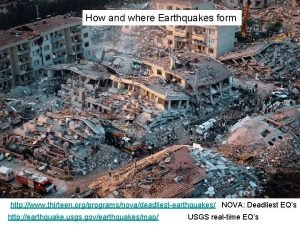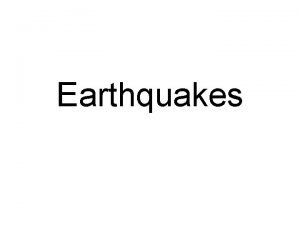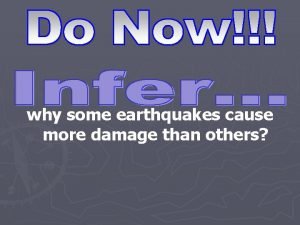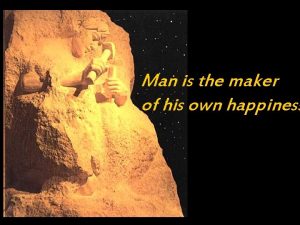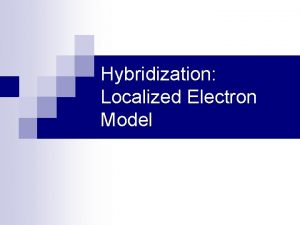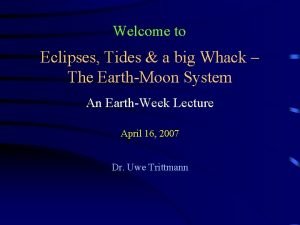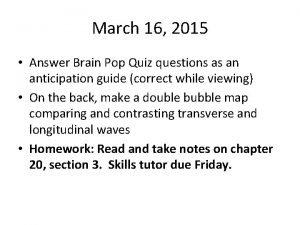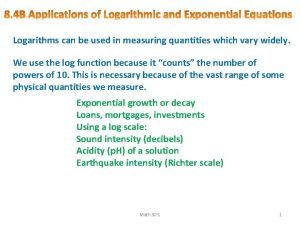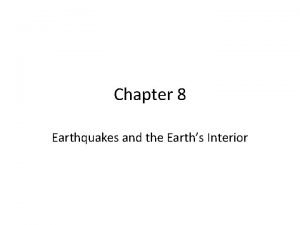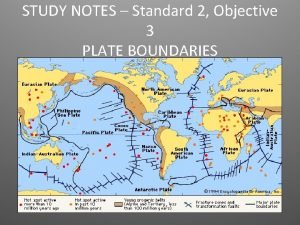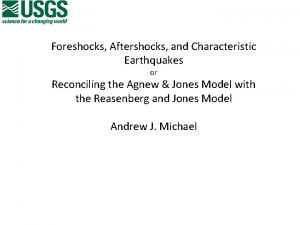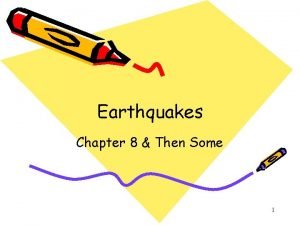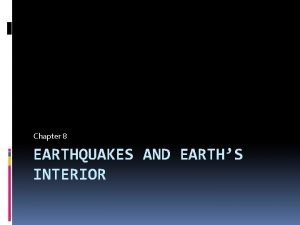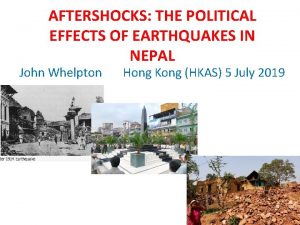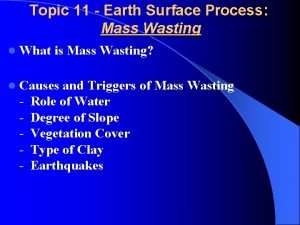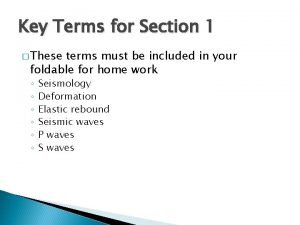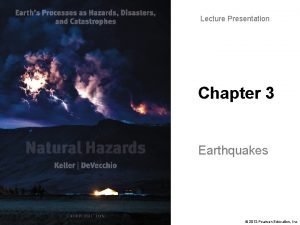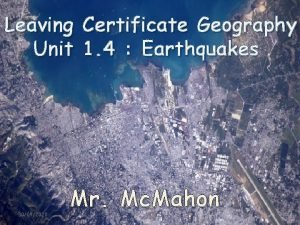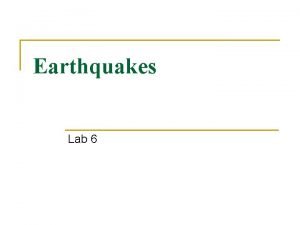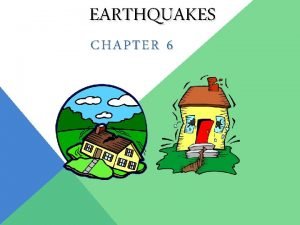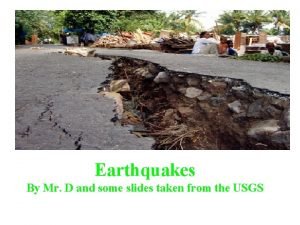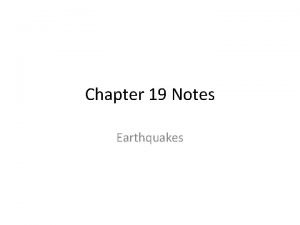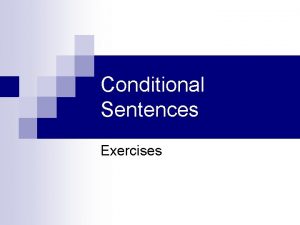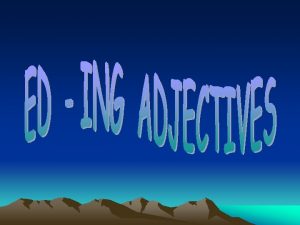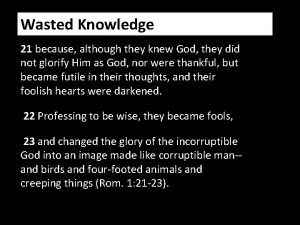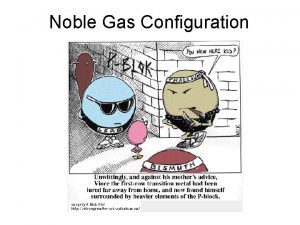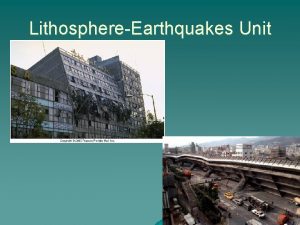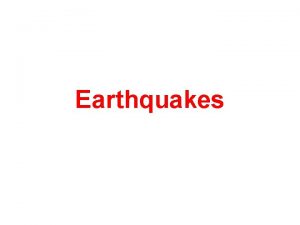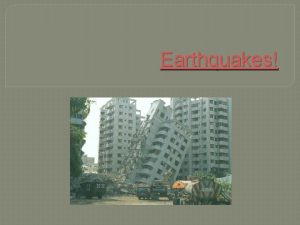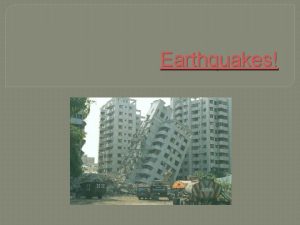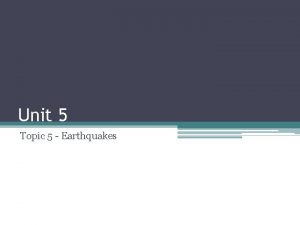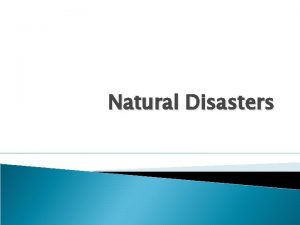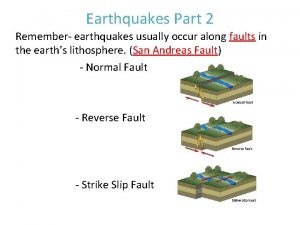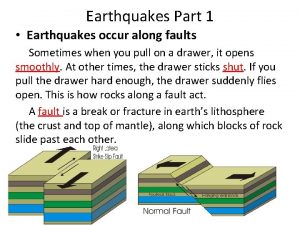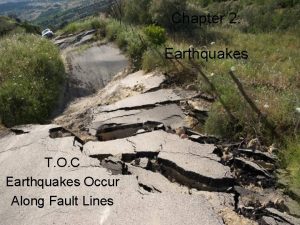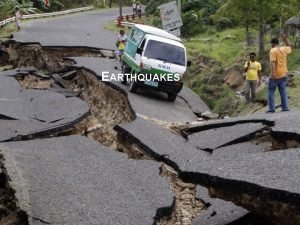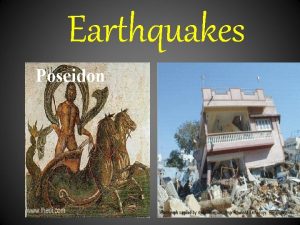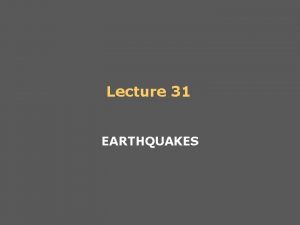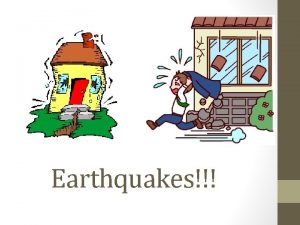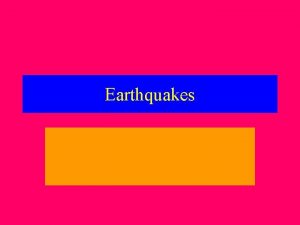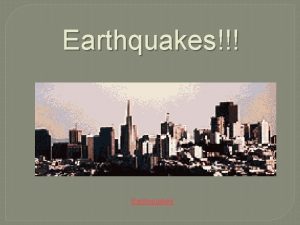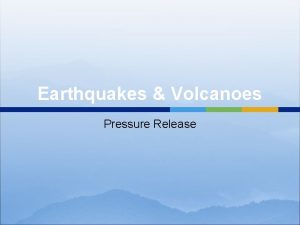What are earthquakes Why do they occur Where














































- Slides: 46


What are earthquakes ? Why do they occur? Where do they occur?

Where do Earthquakes Occur? • Earthquakes can occur near the Earth’s surface or far below the surface. • Most earthquakes occur at plate boundaries • But some happen at faults located in the middle of tectonic plates.

Plate boundaries are prime earthquake zones!

Earthquake Locations Around the World

What Causes Earthquakes? Earthquakes are caused when STRESS FORCES build along faults and then are suddenly released. Tension forces / Tensile forces – either side of a fault is pulling away from each other. This happens at divergent plate boundaries. Compression forces – either side of a fault is pressing against each other. This happens at convergent plate boundaries. Shearing forces – either side of a fault is sliding past each other. This happens at transform boundaries.

STRESS CAUSES ROCK TO CHANGE Elastic Deformation Rock folds and stretches until it deforms. Rock is stretched and bent until it can no longer take the stress. EARTHQUAKE! Elastic Rebound No longer under stress, the rock returns to its original shape

Elastic ELASTIC REBOUND


Earthquakes in Pennsylvanai? ? n Do we live near a plate boundary? n Do we live near a fault?

USA Fault Systems

The New Madrid Fault Under the Mississippi? ? !! n n The New Madrid Fault Zone is part of an ancient plate boundary. In this area, the North American Plate tried to form a divergent plate boundary about 500 million years ago. The splitting stopped before new plates could form. Earthquakes occur because the North American Plate is still "settling down". The faults in the New Madrid Zone do not reach the Earth’s surface but are connected to other faults closer to home!

East Coast Fault and Ramapo Fault Systems The ancient Ramapo Fault System --- runs through the eastern part of the PA. Smaller modern faults in Pennsylvania and along the Ramapo Fault Line are forming and becoming active!

Earthquakes of Pennsylvania 1965 -2012

Lesson 2

3 Types of Faults associated with Earthquakes PLATE MOTION FAULT TYPE Transform Strike –Slip Fault Convergent Reverse Fault Divergent Normal Fault

Strike-Slip Fault occurs at a Transform Boundary


Reverse Fault occurs at a Convergent Boundary


Normal Faults occur at Divergent Boundaries




Chapter 8: Sections 1: Earthquakes and Faults: Organizer PLATE MOTION FAULT TYPE Transform Strike –Slip Fault Plates move past each other Fault blocks move past each other Convergent Plates move together Reverse Fault blocks move together Divergent Plates move apart Normal Fault blocks move apart

Lesson 3

How do Earthquake Waves Travel? Energy released from moving plates and faults Travels through the Earth in Seismic waves.

Types of Seismic Waves 1. BODY WAVES: Seismic waves that travel through the Earth. 2. SURFACE WAVES: Seismic waves that travel along the surface. n WAVES TRAVEL: 1. At different speeds and 2 In different ways Depending on what kind of material they are moving through.

Body Waves • There are two types of body waves: – P-waves – S-waves

P-waves n n n n P-waves are pressure waves. P-waves travel through solid, liquids and gases. P-waves are the fastest waves. P-waves are the first waves to be detected and the first waves to arrive. P-waves are also called primary waves because they arrive first. P-waves cause rock to squeeze and stretch. Imagine a slinky! The area of the Earth that does not receive seismic energy is called the shadow zone.

1. P-Waves

2. S-waves are the second fastest waves. n S-waves are also called secondary waves because they arrive second. n S-waves are slower than P-waves. n S-waves move rock from side to side. n n S-waves can’t travel through parts of the Earth that are completely liquid.

S-Waves

3. Surface Waves • Surface waves move along the surface of the Earth. • Surface waves can move up, down and around or side to side. • Surface waves move the slowest and cause the most destruction.

Surface Waves

Seismic Wave Arrival • First- P-waves • Second- S-waves • Third- Surface Waves

Shadow Zone The shadow zone results from S waves being stopped entirely by the liquid core and P waves being bent (refracted) by the liquid core.

Moho Zone The Moho is the boundary between the crust and the mantle in the earth. This is a depth where seismic waves usually increase velocity, or speed and direction.

Quiz • • • 1. Most Earthquakes occur along ________. 2. The first seismic waves to arrive are_______. 3. The second seismic waves to arrive are _______. 4. The last seismic waves to arrive are________. 5. Which seismic waves travel the fastest? ______ 6. Which type of seismic wave can move through a solid, liquid or a gas? ________ • 7. Which seismic wave cannot travel through material that is completely liquid? _______ • 8. Which seismic waves are the slowest and the most destructive? ________

Lesson 4 Earthquake Measurement

Seismograph • A seismograph is an instrument used by scientists to measure earthquakes – determines the strength and location! Ancient Chinese Seismograph. The ball would drop from the dragon to the frog. It told the people which direction the earthquake come from.

Seismograms 0 1 2 3 Time in Minutes 4 5 6 1. How many minutes did it take for the P-Waves to arrive? 2. How many minutes did it take for the S-waves to arrive? 3. How long did the surface waves last? 7 8

Epicenter • The epicenter is the point on the Earth’s surface directly above an earthquake’s starting point.

Focus • The focus is the point inside the Earth where the earthquake begins. • The epicenter is located directly above the focus.

Measuring Earthquakes • There are two major ways earthquakes are measured: 1. Richter Scale 2. Mercalli Scale

Richter Scale measures magnitude or energy released by an earthquake Less than 3. 5 - Generally not felt, but recorded. 3. 5 -5. 4 - Often felt, but rarely causes damage. Under 6. 0 -At most slight damage to well-designed buildings. Can cause major damage to poorly constructed buildings 6. 1 -6. 9 - Can be destructive in areas up to about 100 kilometers across where people live. 7. 0 -7. 9 - Major earthquake. Can cause serious damage over larger areas. 8 or greater- Great earthquake. Can cause serious damage in areas several hundred kilometers across.
 Why do earthquakes occur
Why do earthquakes occur Mikael ferm
Mikael ferm Seismograph
Seismograph The ______ of a seismograph moves.
The ______ of a seismograph moves. Hey hey bye bye
Hey hey bye bye Why does rigor mortis occur
Why does rigor mortis occur Why does hybridization occur
Why does hybridization occur Why does hybridization occur
Why does hybridization occur Why did the yazoo land fraud occur?
Why did the yazoo land fraud occur? Big whack theory
Big whack theory Why does refraction occur brainpop
Why does refraction occur brainpop In what section of earth do earthquakes happen
In what section of earth do earthquakes happen Btn earthquakes
Btn earthquakes Chapter 8 section 1 what are earthquakes answer key
Chapter 8 section 1 what are earthquakes answer key Define natural disasters
Define natural disasters Http://earthquake.usgs.gov/earthquakes/map/
Http://earthquake.usgs.gov/earthquakes/map/ Chapter 8 earthquakes and volcanoes
Chapter 8 earthquakes and volcanoes A large crack in the earth formed by a river or earthquakes
A large crack in the earth formed by a river or earthquakes Chapter 8 earthquakes and earth's interior
Chapter 8 earthquakes and earth's interior Chapter 19 earthquakes
Chapter 19 earthquakes Frequent earthquakes in an area may indicate *
Frequent earthquakes in an area may indicate * Earthquakes
Earthquakes Chapter 8 quiz 1
Chapter 8 quiz 1 Chapter 8 earthquakes and earth's interior
Chapter 8 earthquakes and earth's interior Earthquakes
Earthquakes Landslides caused by earthquakes
Landslides caused by earthquakes Elastic rebound
Elastic rebound What are the factors of earthquake
What are the factors of earthquake 5 effects of earthquakes
5 effects of earthquakes The richer scale
The richer scale Crust definition
Crust definition Earthquake causes in points
Earthquake causes in points Whats the main cause of earthquakes
Whats the main cause of earthquakes Types of faults
Types of faults Chapter 19 earthquakes
Chapter 19 earthquakes Dont ask why why why
Dont ask why why why Rankings: what are they and do they matter?
Rankings: what are they and do they matter? 2. if we sneak out quietly, nobody notice.
2. if we sneak out quietly, nobody notice. They seek him here they seek him there
They seek him here they seek him there I have not rejected you
I have not rejected you They are they which testify of me
They are they which testify of me Grammar rules frustrate me they're not logical they are so
Grammar rules frustrate me they're not logical they are so For they not know what they do
For they not know what they do Knowledge not shared is wasted
Knowledge not shared is wasted What is wind
What is wind What is noble gas configuration
What is noble gas configuration Ancient greece theatre masks
Ancient greece theatre masks
